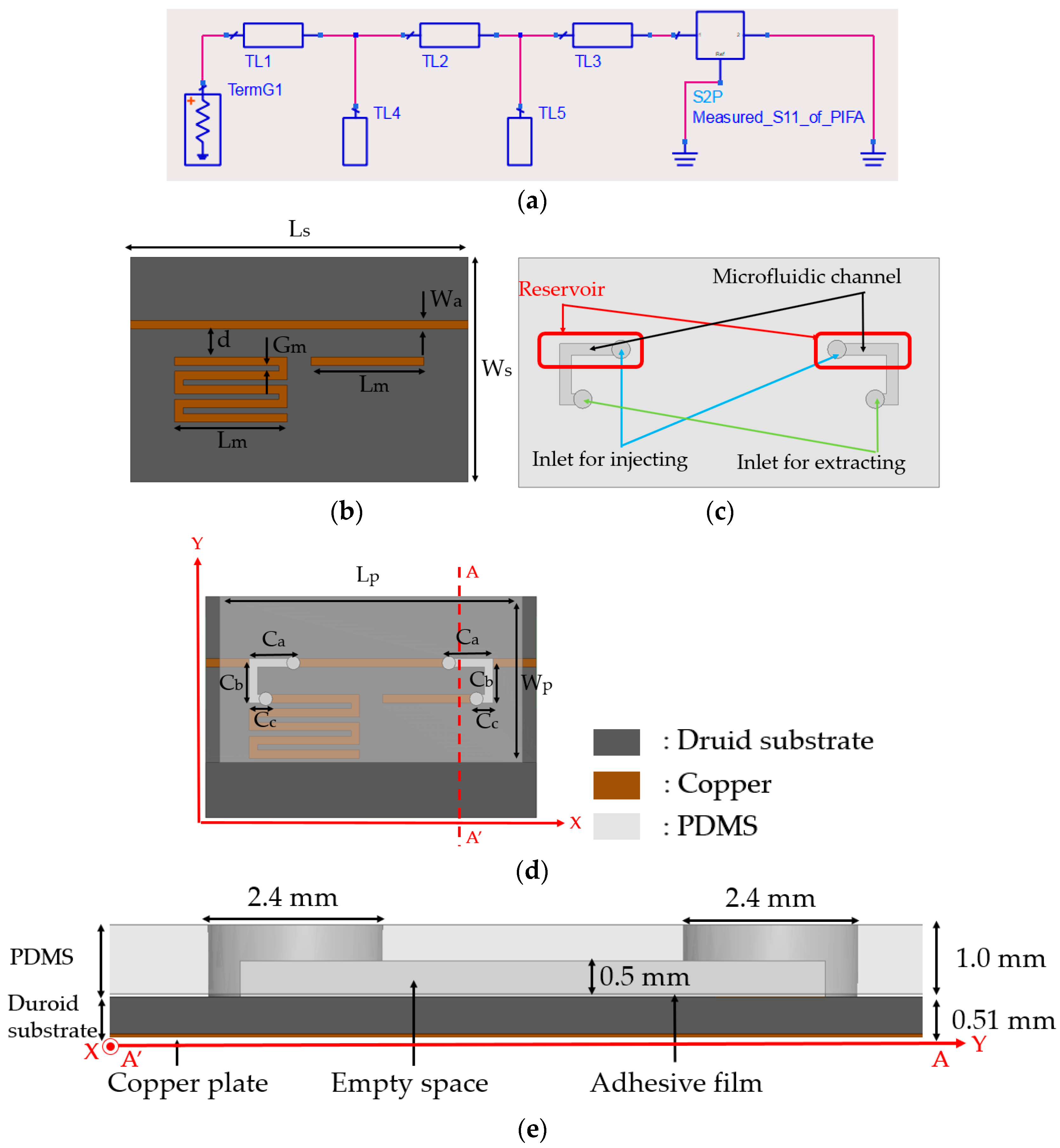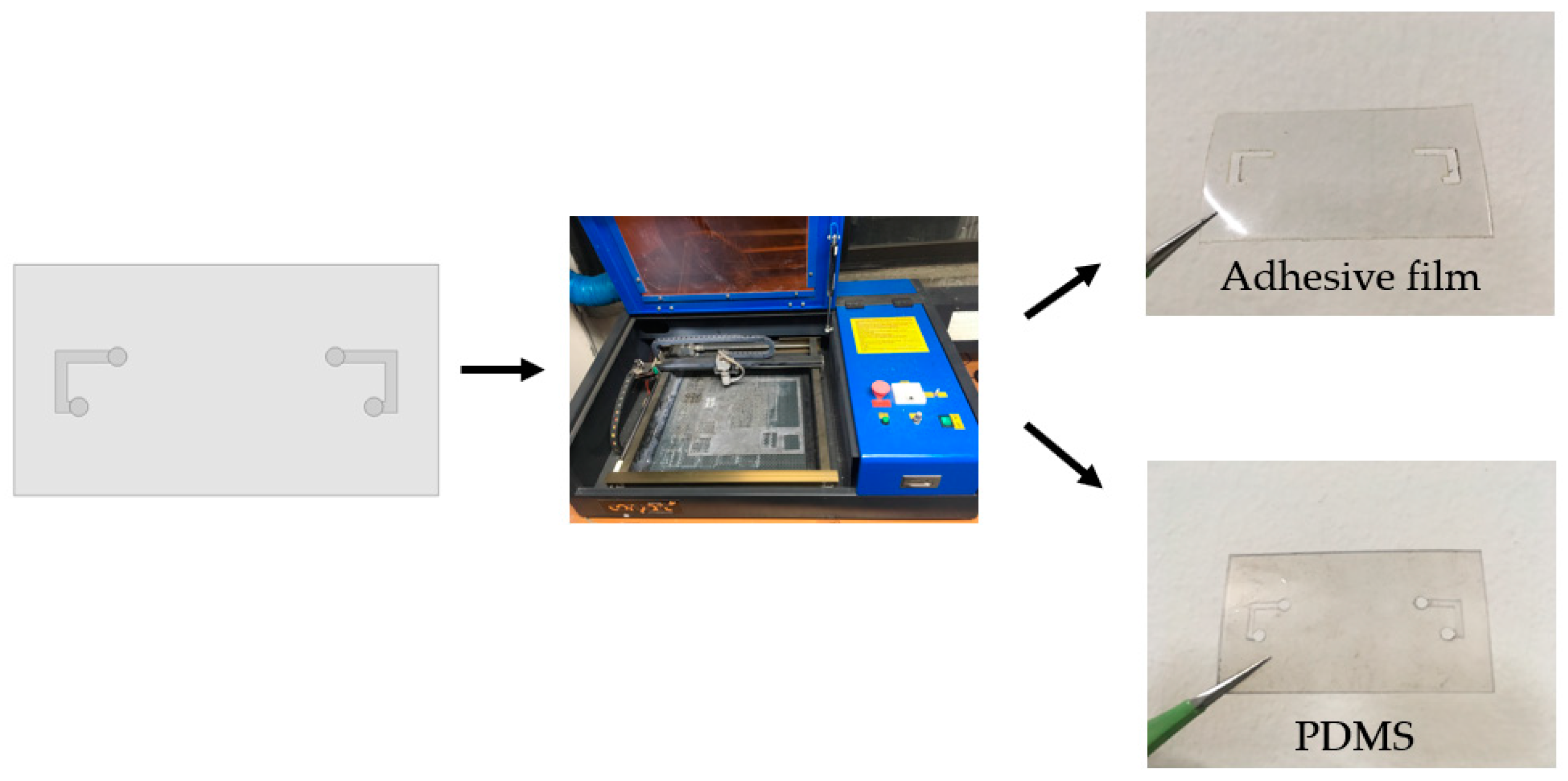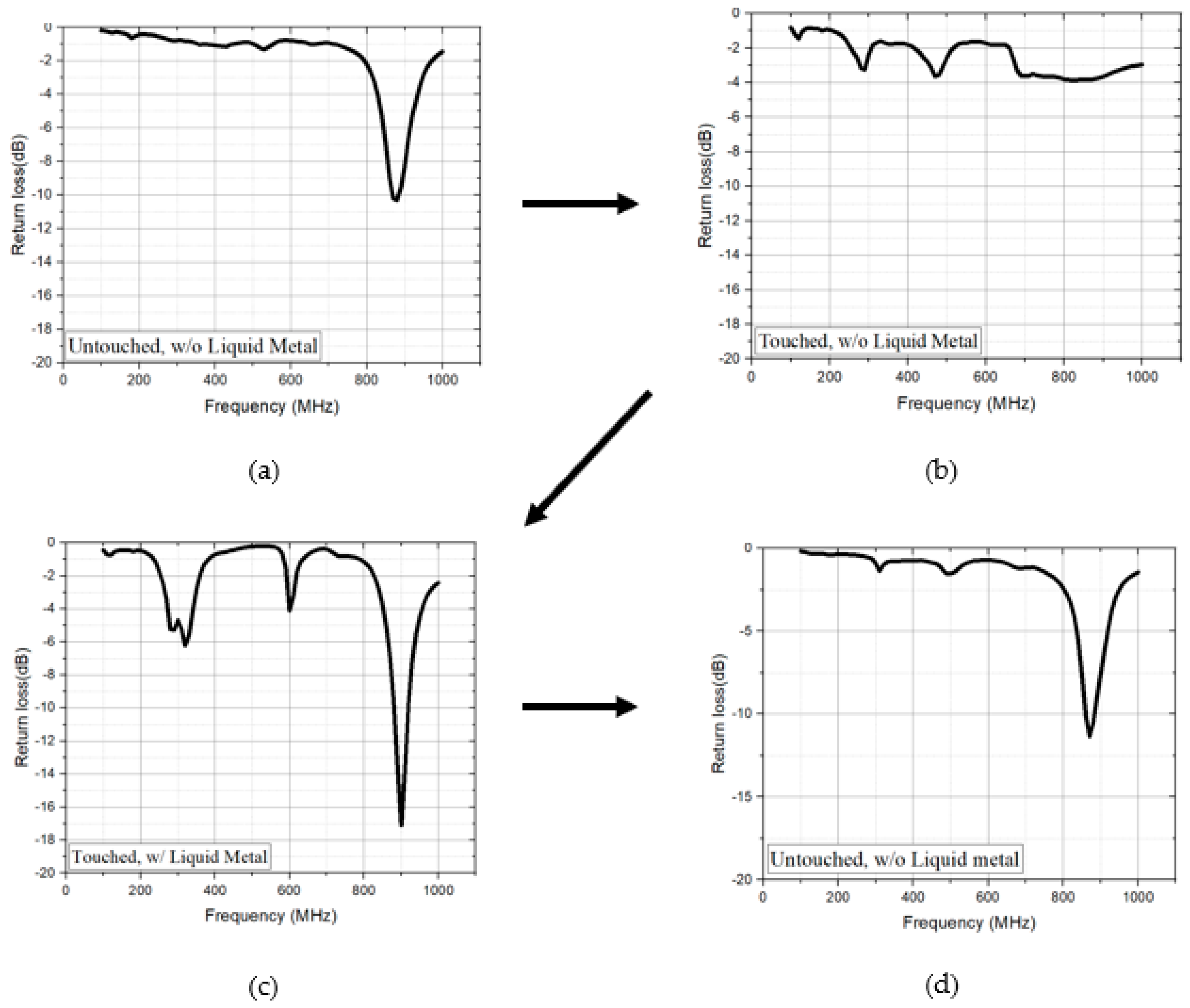Planar Inverted-F Antenna (PIFA) Using Microfluidic Impedance Tuner
Abstract
:1. Introduction
2. Design of PIFA and Microfluidic Impedance Tuner
2.1. PIFA Design
2.2. Impedance Measurement at Touched and Untouched States
2.3. Microfluidic Impedance Tuner Design
3. Fabrication and Measurement Result
3.1. Fabrication of Microfluidic Channel
3.2. Microcontroller and Micropump
3.3. Measurement Result
3.4. Instill Rate
4. Conclusions
Author Contributions
Funding
Conflicts of Interest
References
- Boyle, K.R.; Yuan, Y.; Ligthart, L.P. Analysis of mobile phone antenna impedance variations with user proximity. IEEE Trans. Antennas Propag. 2007, 55, 364–372. [Google Scholar] [CrossRef]
- Zhou, Z.; Melde, K.L. Frequency agility of broadband antennas integrated with a reconfigurable RF impedance tuner. IEEE Antennas Wirel. Propag. Lett. 2007, 6, 56–59. [Google Scholar] [CrossRef]
- Bae, Y.; Kim, U.; Kim, J. A Programmable impedance tuner with finite SWRs for load-pull measurement of handset power amplifiers. IEEE Microw. Wirel. Compon. Lett. 2015, 25, 268–270. [Google Scholar] [CrossRef]
- Bouvot, S.; Carlos, J.; Goncalves, A.; Bossuet, A.; Quémerais, T.; Ducournau, G.; Danneville, F.; Gloria, D.; Monnet, J. A 140 GHz to 160 GHz active impedance tuner for in-situ noise characterization in BiCMOS 55 nm. In Proceedings of the 2017 IEEE International Symposium on Radio-Frequency Integration Technology (RFIT), Seoul, South Korea, 30 August–1 September 2017; pp. 153–155. [Google Scholar]
- Vähä-Heikkilä, T.; Varis, J.; Tuovinen, J.; Rebeiz, G.M. A 20-50 GHz RF MEMS single-stub impedance tuner. IEEE Microw. Wirel. Compon. Lett. 2005, 15, 205–207. [Google Scholar] [CrossRef]
- Quaglia, R.; Andersson, C.M.; Fager, C.; Pirola, M. A double stub impedance tuner with SiC diode varactors. In Proceedings of the Asia-Pacific Microwave Conference 2011, Melbourne, VIC, Australia, 5–8 December 2011; pp. 267–270. [Google Scholar]
- Gu, Q.; De Luis, J.R.; Morris, A.S.; Hilbert, J. An analytical algorithm for Pi-network impedance tuners. IEEE Trans. Circ. Syst. I Regul. Pap. 2011, 58, 2894–2905. [Google Scholar] [CrossRef]
- Van Bezooijen, A.; De Jongh, M.A.; Chanlo, C.; Ruijs, L.C.H.; Van Straten, F.; Mahmoudi, R.; Van Roermund, A.H.M. A GSM/EDGE/WCDMA adaptive series-LC matching network using RF-MEMS switches. IEEE J. Solid-State Circ. 2008, 43, 2259–2268. [Google Scholar] [CrossRef]
- Tabor, C.; Champion, M.; Cumby, B. Materials for liquid RF electronics long term operation of gallium liquid metal alloys in reconfigurable RF applications. In Proceedings of the 2017 IEEE International Symposium on Antennas and Propagation & USNC/URSI National Radio Science Meeting, San Diego, CA, USA, 9–14 July 2017; pp. 409–410. [Google Scholar] [CrossRef]
- Park, E.; Lim, D.; Lim, S. Dual-band band-pass filter with fixed low band and fluidically-tunable high band. Sensors 2017, 17, 1884. [Google Scholar] [CrossRef] [PubMed]
- Memon, M.U.; Lim, S. Microfluidic high-Q circular substrate-integrated waveguide (SIW) cavity for radio frequency (RF) chemical liquid sensing. Sensors 2018, 18, 143. [Google Scholar] [CrossRef] [PubMed]
- Ali, M.M.; Narakathu, B.B.; Emamian, S.; Chlaihawi, A.A.; Aljanabi, F.; Maddipatla, D.; Bazuin, B.J.; Atashbar, M.Z. Eutectic Ga-In liquid metal based flexible capacitive pressure sensor. In Proceedings of the 2016 IEEE SENSORS, Orlando, FL, USA, 30 October–3 November 2016; pp. 1–3. [Google Scholar]
- Nguyen, T.T.; Lim, S. Bandwidth-enhanced and Wide-angle-of-incidence Metamaterial Absorber using a Hybrid Unit Cell. Sci. Rep. 2017, 7, 1–11. [Google Scholar] [CrossRef] [PubMed]
- Lim, D.; Lim, S. Liquid-metal-fluidically switchable metasurface for broadband and polarization-insensitive absorption. IEEE Access 2018, 6, 40854–40859. [Google Scholar] [CrossRef]
- Kelley, M.; Huff, G.; Lawrence, B.; Koo, C.; Li, S.; Han, A.; McQuilken, H. Frequency reconfigurable patch antenna using liquid metal as switching mechanism. Electron. Lett. 2013, 49, 1370–1371. [Google Scholar] [CrossRef]
- Chen, C.H.; Whalen, J.; Peroulis, D. Non-toxic liquid-metal 2-100 GHz MEMS switch. In Proceedings of the 2007 IEEE/MTT-S International Microwave Symposium, Honolulu, HI, USA, 3–8 June 2007; pp. 363–366. [Google Scholar]
- Morishita, A.M.; Dang, J.H.; Gough, R.C.; Ohta, A.T.; Shiroma, W.A. A tunable amplifier using reconfigurable liquid-metal double-stub tuners. In Proceedings of the 2015 Texas Symposium on Wireless and Microwave Circuits and Systems (WMCS), Waco, TX, USA, 23–24 April 2015; pp. 1–4. [Google Scholar]
- Lei, B.J.; Hu, W.; Ohta, A.T.; Shiroma, W.A. A liquid-metal reconfigurable double-stub tuner. In Proceedings of the 2012 IEEE/MTT-S International Microwave Symposium Digest, Montreal, QC, Canada, 17–22 June 2012; pp. 1–3. [Google Scholar]
- Yun, J.; Choi, J. Low-Profile Planar Inverted-F Antenna for Ultrawideband Applications. J. Electr. Eng. Sci. 2016, 16, 235–240. [Google Scholar] [CrossRef]
- Yousaf, J.; Jung, H.; Kim, K.; Nah, W. Design, Analysis, and Equivalent Circuit Modeling of Dual Band PIFA Using a Stub for Performance Enhancement. J. Electr. Eng. Sci. 2016, 16, 169–181. [Google Scholar] [CrossRef] [Green Version]








© 2018 by the authors. Licensee MDPI, Basel, Switzerland. This article is an open access article distributed under the terms and conditions of the Creative Commons Attribution (CC BY) license (http://creativecommons.org/licenses/by/4.0/).
Share and Cite
Lee, M.; Lim, S. Planar Inverted-F Antenna (PIFA) Using Microfluidic Impedance Tuner. Sensors 2018, 18, 3176. https://doi.org/10.3390/s18103176
Lee M, Lim S. Planar Inverted-F Antenna (PIFA) Using Microfluidic Impedance Tuner. Sensors. 2018; 18(10):3176. https://doi.org/10.3390/s18103176
Chicago/Turabian StyleLee, Minjae, and Sungjoon Lim. 2018. "Planar Inverted-F Antenna (PIFA) Using Microfluidic Impedance Tuner" Sensors 18, no. 10: 3176. https://doi.org/10.3390/s18103176




